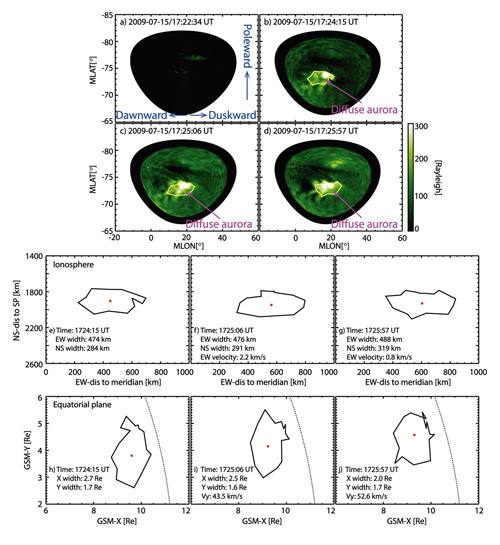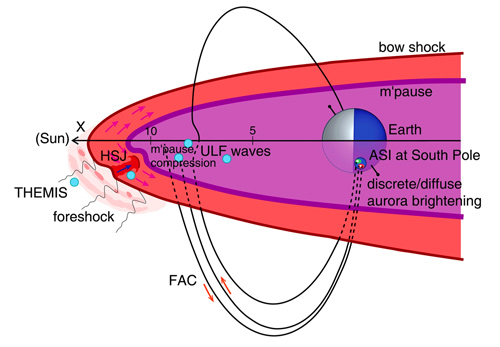
2018 THEMIS SCIENCE NUGGETS
Impacts of Magnetosheath High-Speed Jets on the Magnetosphere and Ionosphere Measured by Optical Imaging and Satellite Observations
by Boyi Wang
Center for Space Physics, Boston University
Introduction
The magnetosheath is a highly turbulent region between the bow shock and magnetopause of Earth. The dynamic pressure in the subsolar magnetosheath is generally lower than that in the upstream solar wind. However, transient impulses of the dynamic pressure occasionally occur in the magnetosheath, which are usually associated with increases in plasma density and anti-sunward flows. These characteristics in the subsolar magnetosheath are denoted as magnetosheath high-speed jets (HSJs). In previous reported events, magnetosheath HSJs can impact the coupled Magnetosphere-Ionosphere system significantly. The impacts include compressing the magnetosphere, causing ultra-low frequency waves and interrupting the current system. Since the interruptions in the current system and waves can usually be observed in optical images as aurora emissions, in this study we address if magnetosheath HSJs affect dayside aurora. And if so, ground-based imaging can provide high resolution 2-D measurements of HSJ-driven ionospheric and, by inference, magnetospheric disturbances.
To approach that goal, we use the coordinated observations by THEMIS satellites and the all-sky imager at South Pole station during 2008-2010. We found eight conjunction events in total, and one of those is shown here as an example.
| Figure 1. (a) The orbits of the THEMIS satellites during 1600–1800 UT on 15 July 2009. The orange shadow shows the longitude coverage of the field-of-view of the all-sky imager at South Pole station. (b) Solar wind observation by THEMIS B during 1710–1750 UT. The panels shown are (ba) dynamic pressure, (bb) interplanetary magnetic field (IMF) in the geocentric solar magnetospheric (GSM) coordinates, (bc) IMF cone angle, and (bd) ion energy flux. (c) Magnetosheath observations by THEMIS C during 1710–1750 UT. The panels shown are (ca) plasma density, (cb) flow velocity, (cc) total (black) and GSM-X component (blue) of dynamic pressure, (cd) magnetic field, (ce) electron energy flux, (cf) ion energy flux, and E-W keograms of (cg) 630.0-nm and (ch) 557.7-nm wavelength. The magenta shadows indicate two high-speed jets and the magenta dashed lines indicate their initiation times. The white vertical dashed lines show the beginning of aurora brightening. |
THEMIS observation of two HSJs on 15 July 2009
We show one case on 15 July 2009 identified by Plaschke et al. (2013). In this event, both of the all-sky imagers at South Pole station and the THEMIS satellites were in the dayside region. More specifically, the five THEMIS probes were located in the solar wind, the magnetosheath, and the magnetosphere in the post-noon region, respectively (Figure 1A), which was ideal to investigate solar wind-magnetosheath-magnetosphere interaction. Two magnetosheath HSJs were identified during ~1722–1726 UT and ~1727–1730 UT (indicated by magenta shadows in Figures 1Ca-1Cf) by THEMIS C. They were both associated with significant increases in plasma density, anti-sunward flow velocity, and dynamic pressure. On the other hand, THEMIS B didn’t observe a corresponding significant dynamic increase in the solar wind (Figure 1Ba), indicating that the magnetosheath HSJs were generated in the magnetosheath while not in the pristine solar wind. THEMIS D and E show that the magnetosheath HSJs compressed the dayside magnetosphere and generated ultra-low frequency waves.
| Figure 2. (a–d) First brightening pattern of diffuse aurora in 557.7 nm at 1722:34, 1724:15, 1725:06, and 1725:57 UT on 15 July 2009. The x and y axes show magnetic longitude and latitude. The yellow contour lines identify the first brightening pattern of diffuse aurora. (e–g) Shapes of the contour lines at the altitude of ~110 km at 1724:15, 1725:06, and 1725:57 UT, respectively. The x axis shows the distance to an arbitrary reference meridian, and the y axis shows the distance to magnetic South Pole. (h–j) Mapped patterns in the equatorial plane by the T01 model at 1724:15, 1725:06, and 1725:57 UT, respectively. The dashed curves indicate the position of the model magnetopause. |
2D measurements of the two HSJs by optical images
The east-west keograms of red-line (Figure 1Cg) and green-line (Figure 1Ch) emissions highlight the discrete and diffuse auroral activities, respectively. It is shown that both discrete and diffuse aurora brightened twice around the two HSJs, respectively. The green-line emission also shows subsequent brightenings with ~5-min recurrence periods. This signature may indicate ultra-low frequency waves excited by magnetospheric compression.
Since the aurora responses have been identified in keograms, we can further take advantage of 2-D optical observations of discrete and diffuse auroral brightening patterns. Figures 2a–2d present the green-line snapshots (diffuse auroral activities). The boundary of the structures is indicated by the yellow contour lines. The east-west width of the brightening pattern varied from 474 to 488 km. The pattern propagated duskward with an average east-west velocity of 1.5 km/s. By mapping to the equatorial plane using the T01 model, the azimuthal size of the auroral brightened pattern varied from 2.0 to 2.7 Re, which was larger but still comparable to the size of the HSJs, which was ~0.93 Re. The duskward velocity of the pattern was 43.5 and 52.6 km/s at 1725:06 and 1725:57 UT, respectively. It is noted that both the magnitude and the direction of the velocity were consistent with background velocity of the magnetosheath flow (Figure 1Cb), indicating that the motion of the magnetopause compression that drove the diffuse aurora is probably controlled by background magnetosheath flows.
| Figure 3. Illustration of the high-speed jets’ impacts on dayside magnetosphere and aurora. Here, ULF, FAC and ASI indicate ultra-low frequency, field-aligned current and all-sky imager, respectively. |
Conclusion
This study presents magnetospheric and auroral responses to magnetosheath HSJs based on the coordinated observation between the THEMIS satellites and the ASI at South Pole station during 2008 through 2010. All eight HSJ events in the analysis exhibited clear association between magnetosheath HSJs and discrete/diffuse aurora brightenings, and in five events, the magnetosheath HSJs were accompanied ultra-low frequency waves. The average 2-D properties of HSJ effects on the coupled magnetosphere-ionosphere system are examined based on those events.
The study found that although magnetosheath HSJs are localized disturbances, they are quite geoeffective, including triggering ultra-low frequency waves in the magnetosphere and discrete/diffuse auroral brightenings. These are similar to interplanetary shocks except that the HSJ-related responses are localized. Additionally, the discrete auroral brightenings likely reflect significant field-aligned currents, which are associated with a corresponding electric field enhancement, further demonstrating the magnetosphere-ionosphere coupling driven by magnetosheath HSJs. The schematic illustration is shown in Figure 3.
Future work will aim to expand the dataset with recent THEMIS orbits in the magnetosheath and find out how magnetosheath HSJs affect the coupled magnetosphere and ionosphere system in a statistical and 2D perspective.
Reference
Wang, B., Nishimura, Y., Hietala, H., Lyons, L., Angelopoulos, V., Plaschke, F., et al. (2018). Impacts of magnetosheath high‐speed jets on the magnetosphere and ionosphere measured by optical imaging and satellite observations. Journal of Geophysical Research: Space Physics, 123, 4879– 4894. https://doi.org/10.1029/2017JA024954Plaschke, F., Hietala, H., & Angelopoulos, V. (2013). Anti-sunward high-speed jets in the subsolar magnetosheath. Annales Geophysicae, 31, 1877–1889. https://doi.org/10.5194/angeo-31-1877-2013
Biographical Note
Boyi Wang is a Postdoctoral Associate in the Center for Space Physics, Boston University. Her research includes the solar wind-magnetosphere-ionosphere interactions, magnetospheric and ionospheric ultra-low frequency waves and the related auroral phenomena.
 Please send comments/suggestions to
Emmanuel Masongsong / emasongsong @ igpp.ucla.edu
Please send comments/suggestions to
Emmanuel Masongsong / emasongsong @ igpp.ucla.edu



